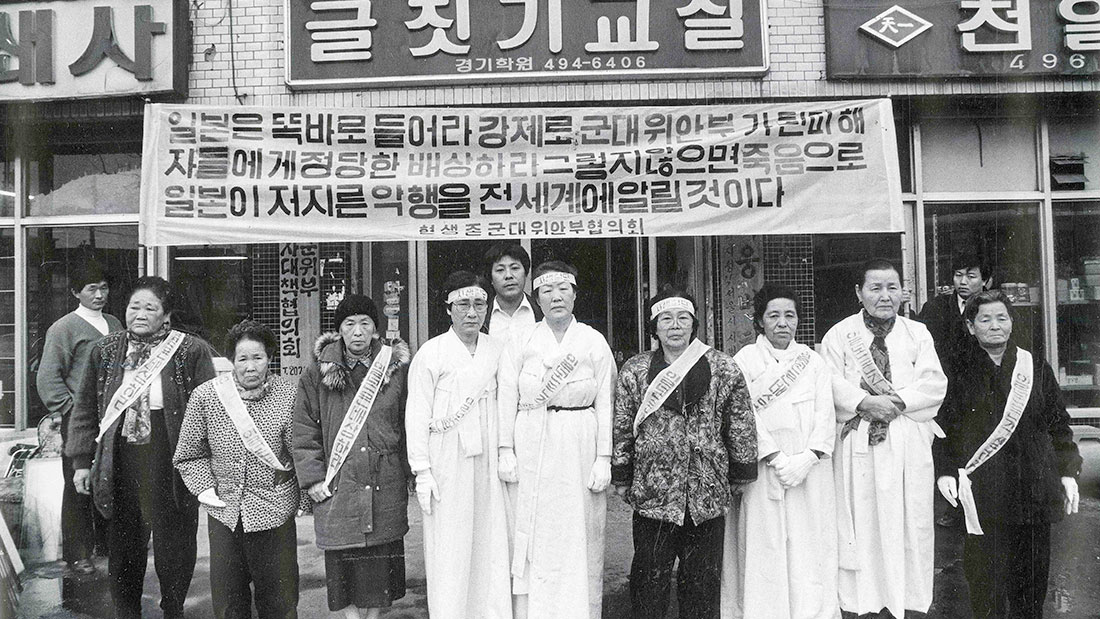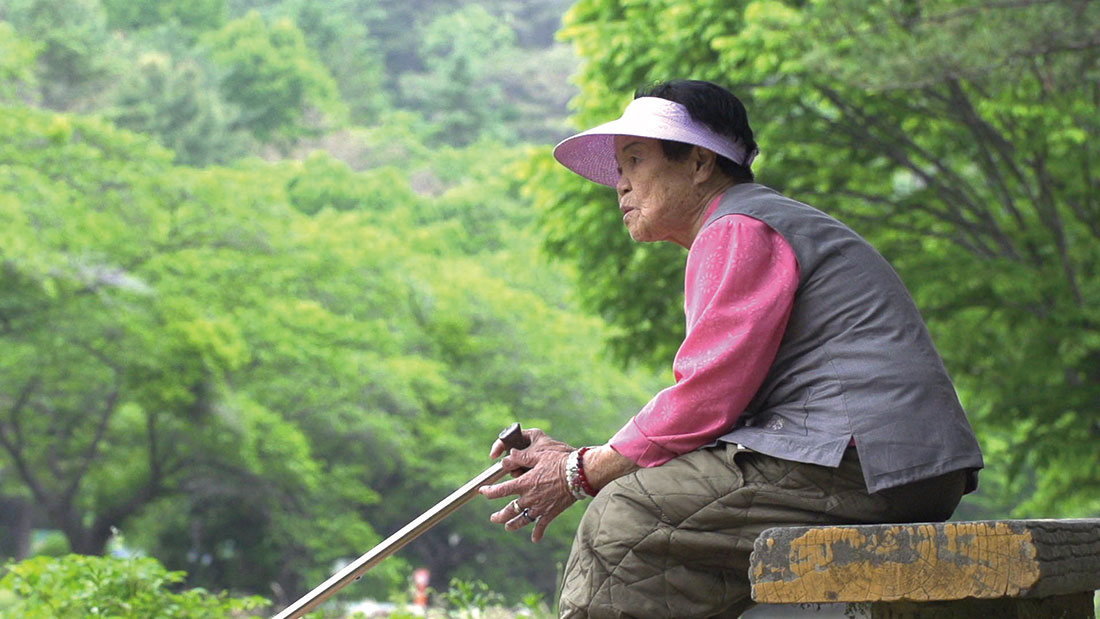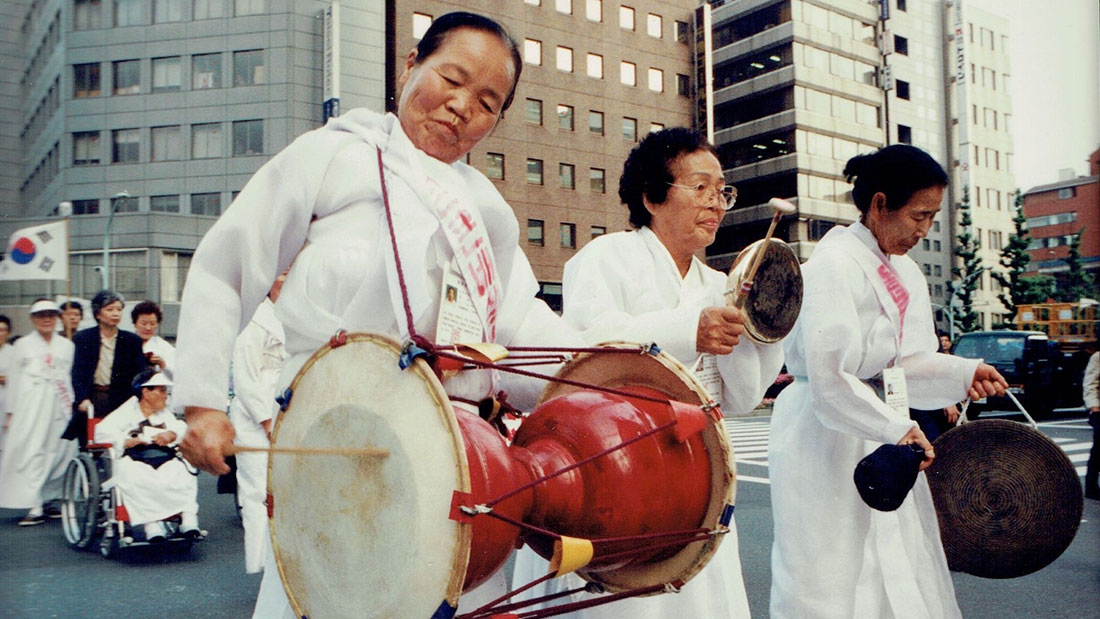Translation of silence, or the representation of the untranslatable[1]
Park Su-nam, the director of “The Silence,” is a Japan-born second-generation Korean, also known as a “Zainichi Korean.” Director Park Su-nam has long recorded erased voices in the gaps of history of the two Koreas and Japan, including the victims of compulsory labour and atomic bombings, through writings and documentary films since starting her career as a journalist in the 1960s. Director Park’s writings and films revolve around those who have been ostracized from a variety of “places” by colonialism, exclusive nationalism, militarism, war, discrimination, and poverty, and whose experiences, memories, and even existence have been denied, crossing the boundaries of ethnicity, gender, and regions. Her most representative book, entitled “Guilt, death, love, and” (罪と死と愛と, 1963), drew the attention of Japanese society to the human rights issues of Zainichi Koreans and inspired the film “Death by Hanging” (1968) directed by Oshima Nagisa. In addition, her other documentary “The Other Hiroshima - Song of Arirang” (1986)[2] captured the lives of Korean victims of the atomic bombing whose voices were excluded in the process of attempting to resolve the issues of compulsive haul, atomic bombings, and postwar compensation, giving a shock to Japan’s antinuclear campaign at that time.
In Japan, the fact that she is a renowned, distinguished figure not only in the Zainichi Korean society but also among those interested in minority human rights movements and research leads her supporters and sponsors to protect her from any right-wing groups’ threat targeting her screening and lectures. In Korea, compared to the situation in Japan, her activities did not receive much attention or even worse, were given distorted assessment within the “Comfort Women” movement.[3] However, in the wake of the release of the documentary “The Silence,” attention to the director is growing among Korean documentary producers and researchers working on the “Comfort Women” issue. In September 2021, the Trans: Asia Screen Culture Institute of the Korea National University of Arts held the international forum Addressing Archives: Women, Diaspora, Filmmaking, honoring her moviemaking and activities. In addition, the Korean Film Archive recently collected and registered the director’s works in the Korean Movie Database (KMDB). Her 16mm films she started shooting in the 1960s but left undeveloped are set to be made into complete works, partly funded by the Korean Film Council.
Silence, the untranslatable

“The Silence” is a film dealing with the struggles of “Comfort Women” victims in Japan who formed a survivors’ association in the mid-1990s without being affiliated with any groups in Korea and Japan, making the history of the “Comfort Women” movement multilayered. In 2016, a provisional edition of about 90 minutes premiered[4] at the Seoul International Women’s Film Festival, and in 2017, a revised edition of about 117 minutes, different from its premiere at the film festival, was released in Japan.[5] Revolving around the activities of the Korean Council for the Women Drafted for Military Sexual Slavery by Japan (hereinafter referred to as the “Korean Council”) that represented the “Comfort Women” movement at the time of 1994 and the Comfort Women Victims Association founded only by victims after separating from the Pacific War Victims Association during their visit to Japan, this film contains the motivation driving her to be involved in the “Comfort Women” issue, the story of director Park being excluded from the “Comfort Women” movement in Korea after “Comfort Women” survivors received the so-called “Asian Women's Fund (AWF),”[6] and the friendship between director Park and “Comfort Women” survivors which continues even after 20 years have passed since then. It also depicts not only the conflict between the members of the General Association of Korean Residents in Japan (Chongryun)[7] and the Korean Residents Union in Japan (Mindan),[8] both of which sought to utilize the meeting with and death of Bae Bong-gi (residing in Okinawa), the first witness to “Comfort Women” victim within Japan, as an asset for social movements but also the process of fierce debates and struggles with the AWF until the victims affiliated to the Comfort Women Victims Association finally decided to receive the fund. All of these matters are rarely told in the history of Korea’s representative “Comfort Women” movement.
However, director Park doesn’t attempt to divulge “what has not been said” or criticize and maintain something in the film. The editing, whether in Japan or Korea, was not done in such a way as to correspond to the retrospective of the existing movements or in contrast, to create a counter-narrative. It is not easy for the audience to follow the internal logic of this film, even though they are accustomed to a documentary whose editing style follows main characters, incidents, or a narrative style sticking to its main topic chronologically. Granted, this film does not choose an experimental or avant-garde narrative style.

At the beginning of the film, director Park remarks through subtitles and old photos of herself that she began to pay attention to activities for the victims of compulsory labour and “Comfort Women” who themselves were the victims of relations between Korea and Japan but had not been organized after she, as a Zainichi Korean, faced the contradictions of the movement of Koreans in Japan during the engagement with it. In other words, this film places a premium on “Comfort Women” victims as well as the director “herself,” who forms an alliance going through time together with them, and its positionality. However, the positionality is not divided smoothly based on the ethnic unity of Koreans or such universal solidarity as the gender identity of women; it is something that the film and the director herself are difficult to be convinced of. Wouldn’t it be that the silence and friction between the rift in the historical narrative of the “Comfort Women” movement within Japan, within Korea, and between Japan and Korea and the discontinuity of the positionality of “Zainichi Koreans” within it constitute the inner logic of this film's editing?
Ahn Min-hwa[9] points out that the recording method, an UN-style voice-over,[10] which director Park adopts and is often seen in her early works including “The Other Hiroshima - Song of Arirang,” is her style of translating the voice of minorities existing in the intersecting history between Korea and Japan, rather than dubbing.[11] Park Su-nam once recalled how she was motivated to start the video work: she felt that during the interviews with Korean victims in Japan, she couldn’t capture something nonverbal and unutterable, including silence, in writing though she was mainly engaged in writing activities at that time.[12] If director Park’s initial interest was “translating,” isn’t she moving into the matter of something untranslatable or untranslatability in “The Silence?” In 2016, director Mun Jeong-hyun, who was in charge of editing “The Silence,” asked her if the film was about the solidarity between the director park herself as a Zainichi Korean and “Comfort Women” victims, that is, the unity between minorities. Park Su-nam answered, “No! Minorities have no option but to live in the structure of constantly creating other minorities! It is not about establishing solidarity!”[13]
The power to seek to divide narratives and the unidentifiable gazes

The first edition of this film, released in 2016, starts with the director herself leaving on a journey to visit the house of Lee Ok-sun, with whom she protested together in the past. Instead of focusing on the history of the “Comfort Women” movement, The first edition has the director herself as an important part, who has been involved in a variety of movements between Korea and Japan. However, at the beginning and end of the final edition that can be seen now, Lee Ok-sun makes an appearance, not the director. In addition, more scenes of testimony from public events (produced and edited in a slightly provocative manner) are added to the footage of the survivors’ protests. It is clear that the first edition is the signature trademark of director Park, who as a Zainichi Korean woman, has suffered a great deal of trouble and continued to be excluded in social movements including Zainichi Korean movements within Japan and between Japan and Korea (and North Korea). Though the final edition still has such traces, it has been edited into the relatively familiar narrative of “Comfort Women” victims.
This is not a matter of which one is better or more right between the two editions. Rather, this process itself raises questions over the range limit of perceiving minorities and social others and the limit of the approaches that documentaries depicting marginalized subjects including “Comfort Women” victims can take.[14]
It is shocking to hear the testimony of murdering a Japanese soldier in Yangon, Myanmar delivered by Moon Ok-ju’s direct voice and gestures in “The Silence,” though the attestation is not the first one. However, What is even more shocking to ruminate over the testimony is that she responded to the Japanese soldier’s death threat with fierce resistance, saying, “The sword the emperor gave is to kill the enemy. Why do you try to kill the same subjects with that sword?”
The comment on the emperor is once again repeated by Lee Ok-sun when she protests against the expression “sexual service” in a meeting with the representatives of the AWF. Lee Ok-sun springs to her feet and recites the Imperial Subjects Oath in a clear and high-pitched voice and then protests that Japan dragged her, saying that it would treat her better than its own people. Their remarks are difficult to understand (in any nationalism-based framework, whether the internalization of colonialism or the coercion of imperialism) and evoke innumerable, undecided spaces between nationalism and post-colonialism.
The first shot of the final edition is an unspecified, elusive scene in identifying whose viewpoint it is before Lee Ok-sun appears. The unidentifiable gaze, the stare of the unconfirmed subject, comes into the first shot. Starting the film with a shot containing a gaze outside the recognition range serves as a harbinger of what’s coming.
Footnotes
- ^ This article overlaps with some of the ideas of my writing “The Location of Translation and its boundaries” published in the 2020 Seoul International Women’s Film Festival Polemics “Translation of Testimony and Oral Statement – Discussing the History of the Military Comfort Women Movement.”
- ^ The original Japanese title is “もうひとつのヒロシマ - アリランのうた.”
- ^ In “A Sixteen-year-old in Pink Skirt and Jeogori” aired on MBC PD Notes on November 5, 1996, director Park Su-nam is maliciously portrayed as “a Zainichi Korean who approached (Comfort Women) Victims to coax them into taking the AWF” and created a disturbance on the funeral of Moon Ok-ju. In the documentary “The Silence,” the conflict with the Korean Council and the Korea entry ban that the Korean Council asked the government for are mentioned.
- ^ https://siwff.or.kr/kor/addon/00000002/history_film_view.asp?m_idx=102620&QueryYear=2016 (October 8, 2021, Search is completed.)
- ^ Under the fact the version available on Purplay (purplay.co.kr), a Korean streaming platform for women’s cinema, is the revised edition made in 2017, and director Park Su-nam made this version official registering the production year as 2017, this article indicates the production year as 2017. The Seoul International Women’s Film Festival reran this final edition in 2020.
- ^ The Asian Women’s Fund reran in 2020.
- ^ Members who belong to the organization consisting of supporters of North Korea among Koreans residing in Japan
- ^ Members who belong to Kyoryū Mindan, an autonomous institution consisting of Koreans residing in Japan
- ^ Affiliated professor of the Korea National University of Arts. She received her master’s degree in Visual Studies from Meiji Gakuin University, in East Asian Comparative Literature from Cornell University, and her Ph.D. in East Asian Studies from the University of Minnesota. She has been conducting comparative studies between Korea and Japan to find ways to go beyond the framework of nationalism inherent in East Asian colonialism and Cold War culture through cultural discourses and practices. (Source: Author Profile on YES24)
- ^ A method of recording Japanese with the director’s own voice over the Korean language or “broken Japanese” mixed with Korean of the first generation of Zainichi Koreans (victims of compulsory labour or atomic bombings) without replacing original dialogue
- ^ Minhwa Ahn, “Archive and Minor Transnational Memory: Documentary of Zainichi Korean Women as Visualizing the Testimony, Space, Image”, the Trans: Asia Screen Culture Institute of the Korea National University of Arts, October 1, 2021, [Addressing Archives: Women, Diaspora and Filmmaking]
- ^ “CINE TALK: Su-nam Park”, the international forum Addressing Archives: Women, Diaspora, Filmmaking, the Trans: Asia Screen Culture Institute of the Korea National University of Arts, September 30, 2021
- ^ Mun Jeong-hyun, “The Silence,” 2016. https://www.kmdb.or.kr/story/12/1050 (October 15, 2021, Search is completed.)
- ^ Director Byun Young-joo often remarks with displeasure that many people who speak gratitude for making a good movie as regards “The Murmuring,” the first part of the director’s documentary trilogy, haven’t actually seen it and think the movie is something they already know not even seeing it. Though “The Murmuring” was an unfamiliar form of an independent documentary movie at that time, the reason it became more acceptable socially to those who didn’t see the movie would be that this movie raised the ethnic issues, which are official and universal, rather than posing a gender issue, according to the director. The damage and suffering of wartime Japanese military sexual abuse victims commonly referred to as “Comfort Women” victims, or “Women’s Labor Corps” victims, are considered to represent a national ordeal, not limited to a women’s issue, and their memories have been selected or processed to be accepted in the public realm. Her book, “Movements on screen: understanding Korean society through independent films,” the Korean Film Archive, 2018, pp. 111.
- Writer Hwang Miyojo
-
Film researcher, lecturer in cinema studies at the Korea National University of Arts, and programmer of the Seoul International Women’s Film Festival.